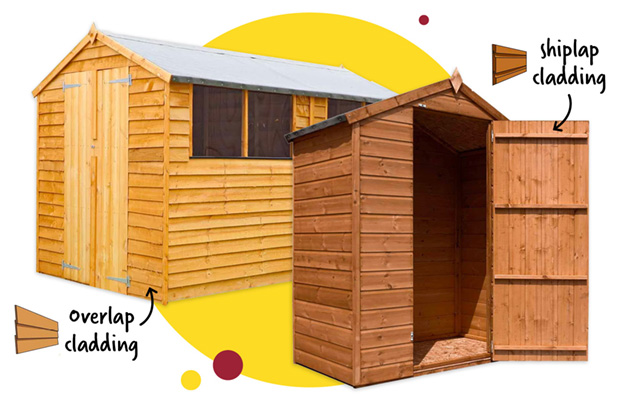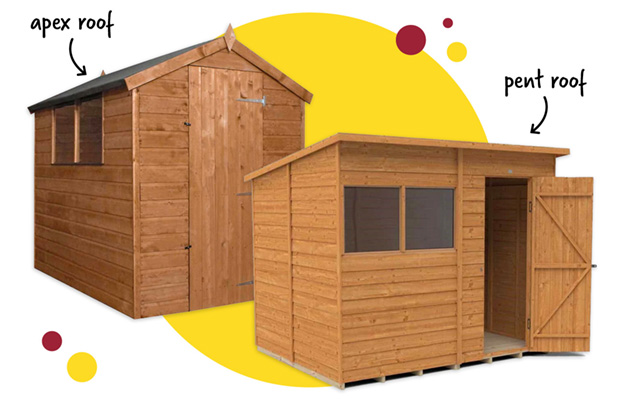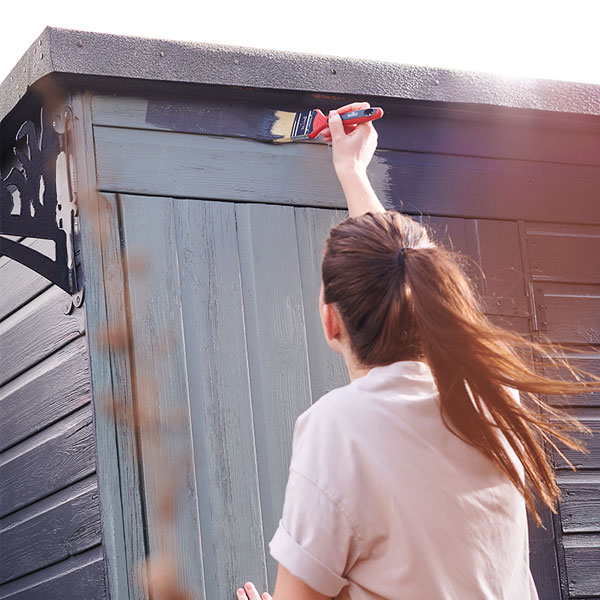How to choose the right shed
The humble garden shed has loads of uses in the garden, and there’s so many to choose from. If you’re wondering which material is best, what size you need, and what on earth a ‘reverse apex’ is, we’ve got all the tips & tricks you need to choose the right shed!
 By Alex
By Alex- 29th May 2024
- 8min read
- This blog was updated on 2nd June 2025
Wooden sheds
Wooden sheds are the classic choice for your garden, with a huge range of sizes, roof types, and cladding types available.
Timber sheds can effortlessly blend in with the natural look of your garden, making them one of the most versatile sheds you can get. From tool sheds to bike sheds, elegant and space-saving corner sheds, and potting sheds for getting ahead with your garden planting, there’s no shortage of options to find your favourite.
Dip treated sheds have wood panels which have been ‘dipped’ in treatment. They’re a cost-effective option for the price-conscious gardener, though you’ll need to keep on top of maintenance once a year to keep it protected from the elements.
Pressure treated sheds go through a more intensive treatment process which makes them more durable and protected. They may cost more, but you won’t have to treat them as often as a dip treated shed.
Cladding: overlap, shiplap, or tongue & groove sheds?
Who knew that the wooden box you use to store your lawn mower had so many variables? Overlap, shiplap, and tongue & groove refer to how the wood panels are connected, and they play an important role in how your shed looks and, more importantly, its durability.
Overlap sheds are usually the most cost-effective choice if you’re looking to save the pennies. With overlap sheds, the wood panels are simply overlapped with each other – a quick and simple construction, though they can be prone to draughts over time.
Shiplap and tongue & groove sheds use a more rigid form of cladding using interlocking wood panels which offers better weather resistance, strength, and a flat surface on which to paint or add shelves.
Shiplap and tongue & groove are almost identical: shiplap is a form of tongue & groove, but with added overlap at the bottom and a distinctive curved edge to help water flow off.

Maintaining your timber shed
Wooden sheds will always respond well to the care that you give them; by keeping on top of aftercare, your shed will look better and last longer! Thankfully, it’s nice and easy to do.
Firstly, you should use a shed base to protect your timber shed from rising damp. More on these later!
Clean dirt off your shed with a brush or pressure washer and make sure it’s dry before painting. We have a great range of shed paint which will rejuvenate the colour as well as hydrate and protect the wood from the weather, both good and bad.
You can read our comprehensive guide on how to paint wood to learn how to paint your shed, which products to use, and how long paint takes to dry!
For everything else to do with shed maintenance, you can check out our blog on how to maintain your shed.
Plastic sheds
If you’re watching the pennies, a plastic shed can be a great value alternative for storing your garden tools and other bits & bobs.
You don’t need a shedload of equipment to set up a plastic garden shed. They’re easy to build and just as easy to maintain, as any dirt on the outside can be simply wiped off.
These weatherproof garden buildings are also quite lightweight compared to timber and metal sheds, making them easier to move – however, that also means it may not offer the same stability and protection than other materials if you’re storing high-value items in there.
Plastic sheds are a popular choice for renting, too! Once the time comes to move out, they’re easy to take apart and lightweight for transporting.
Metal sheds
When it comes to storing high-value items and keeping your outdoor equipment safe, there’s no beating a metal shed! There’s a great variety of sizes available, from simple tool sheds to large metal sheds for storing bikes, lawn mowers, building supplies… you name it, a metal shed can hold it!
Steel sheds are famed for their durability against the elements, keeping things like power tools protected from rain, snow, and almost everything in between. They also require very little maintenance, but you could always top up any scuffs and scrapes with some metal paint.
Unlike wood and plastic sheds, your metal shed stands strong in extreme temperatures without the risk of warping, but they will get hot – with all sheds, proper ventilation is key where possible!
Which shed roof is best?
There are 1000s of sheds out there, in loads of different sizes, configurations, and intended uses. Thankfully, there are only 3 types of roofs:
Apex Sheds
Imagine the shape of a traditional house roof, with 2 sloping sides which meet in the middle at the highest point. Slap a door under there, and you’re got yourself an apex shed.
It’s a classic look, great for water run-off, and has the benefit of added headroom so you can wander about in it without banging your head – always a win.
Having the door on the end of the shed also gives you easy access to the length of the shed, so wheeling in your lawn mower or bikes is nice and easy.
Reverse Apex Sheds
A reverse apex shed is simply an apex shed with the door on the long side instead of at the end.
Reverse apex sheds have the same storage benefits of an apex shed, but with the added benefit of giving easier access to your shed and a design which sits along the wall lengthways. Depending on the space you have, you may find this a better fit.
Pent Sheds
Pent sheds have one sloping roof surface. They’re simple and tidy, great for sheds which sit against a wall, and allowing you to pop a gutter on the lower side. Not only will this protect your shed, but you can add a water butt to harvest rainwater for your gardening. Not sure how? Here’s a guide on how to install a water butt.
You should keep an eye on your shed roof, and check for pesky leaks. When your shed reaches a certain age, you’ll probably want to check out some new roofing kits to keep your belongings safe.

Which shed size is best?
The first thing to consider is the amount of room you have in your garden. Take measurements of where you’d like your shed to go, and don’t forget to leave allowance for the doors to open freely. If your shed is going in an unused corner of your garden, consider using a corner shed which is designed for purpose and won’t stick out as much!
Next, have a think about what you’ll be storing in your shed. If it’ll mostly be simple garden hand tools and plant pots, a small wooden shed or potting shed is all you need to get gardening. If you’re looking for a safe space for the lawn mower, power tools, or bulky workshop machinery, a large metal shed with double doors is probably a winner.
Do I need a shed base?
No matter where it’s going, it’s always a good idea to use a shed base in either the same size, or slightly larger than, your shed. This ensures that your shed sits level, and is protected from rising damp from the ground which can lead to all kinds of problems in the long run and dramatically affect your shed’s lifespan!
Depending on which base you go for, it’s never a bad idea to prepare the ground first before you install your shed base – it’ll get heavy once the shed is on there with everything in it. Using a tiller to clear up the soil before laying down a layer of sand, paving, or stone can help, as can the use of a plate compactor to flatten it all out.
Where should I put my shed?
You should place your shed somewhere out the way but easily accessible, and popping it flush with a wall or fence will give it some protection from the worst of the weather.
For potting sheds, pick a spot that gets plenty of natural light so that your seeds & bulbs can thrive!
Style your shed
There’s no such thing as a boring shed; you just need inspiration!
Add some colour
There’s wood paint available in a dazzling array of colours, so why just settle for boring old brown? Bring some colour to your garden and choose a shade which makes you happy. You can always try a different colour later down the line!
Make it yours
Your shed is going to get a lot of use in the warmer months, so feel free to give it some decoration! We think hanging baskets look great next to the door, adding another splash of colour.
Try lighting up your shed with outdoor string lights – we have solar-powered lights so you don’t have to worry about turning them on and off. Finally, after a long day of gardening, you deserve to sit back and relax a bit, so make sure you keep a couple of folding deck chairs in there so you can take in all your hard work.
Keep it organised
Make sure the shed stays a clutter-free zone with our savvy storage solutions. We’ve got small storage that’s perfect for odds and ends like screws and nails, as well as larger storage for power tools and plant pots.

Congratulations – your shed mission is complete!
Are you particularly proud of your shed setup? Want to show off your garden building decorations? We’d love to hear from you on Facebook, Instagram, Facebook, Instagram or X or TikTok.